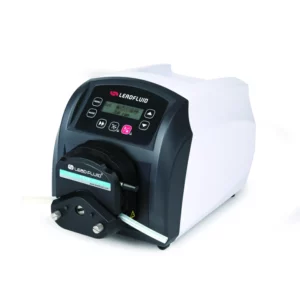The choice of tubing material and size in a peristaltic pump has a significant influence on the appropriate pump speed for a given application. The tubing material and size impact factors such as flow rate, resistance, and dosing accuracy.
Here’s how they interact:
- Flow Rate: The inner diameter of the tubing affects the flow rate of the pump. Larger tubing diameters allow for higher flow rates, while smaller diameters reduce flow. Therefore, the choice of tubing size directly influences the desired flow rate. Users must select tubing with the appropriate diameter to match the desired flow rate for their specific application.
- Tubing Material Compatibility: The tubing material should be compatible with the fluid being pumped. Different materials have different levels of resistance to specific chemicals, solvents, and abrasion. The choice of tubing material ensures that it can withstand the fluid’s properties without degrading or reacting with it.
- Viscosity: The viscosity of the fluid plays a role in determining the appropriate tubing size. High-viscosity fluids may require larger tubing diameters to facilitate flow, while low-viscosity fluids can be pumped through smaller tubing.
- Dosing Accuracy: The tubing material and size can impact dosing accuracy. Smaller tubing sizes tend to provide finer control and dosing precision, while larger tubing may result in less precise dosing due to the potential for fluctuations in flow rate.
- Resistance to Wear: The tubing material’s resistance to wear and abrasion is a consideration, especially when pumping fluids with abrasive particles. Choosing tubing with higher wear resistance ensures a longer tubing life and sustained dosing accuracy.
- Flexibility: The flexibility of the tubing can affect the strength of the peristaltic action. More flexible tubing can create a stronger peristaltic action, allowing for better fluid displacement. This can influence the dosing accuracy and the efficiency of the pump.
- Tubing Length: The length of the tubing in the pump head also plays a role in determining the pump’s performance. Longer tubing may require adjustments to the pump speed to maintain the desired flow rate and accuracy.
- Temperature Resistance: The tubing material should be selected based on the temperature conditions of the application. Some materials are better suited for high-temperature environments, while others are more suitable for low-temperature settings.
- Biocompatibility: In applications involving biological or pharmaceutical fluids, the tubing must be biocompatible to prevent contamination and ensure product integrity.
- Chemical Compatibility: The tubing material must resist chemical interactions with the fluid, ensuring that the fluid’s properties remain stable during pumping.
When selecting tubing material and size for a peristaltic pump, it’s important to consider the specific requirements of the application, including the flow rate, fluid properties, dosing accuracy,China Peristaltic Pump Speed manufacturers and any compatibility or safety considerations. Properly matching the tubing to the application ensures optimal pump performance and accurate dosing.
How is peristaltic pump speed typically controlled or adjusted in pump systems?
Peristaltic pump speed can typically be controlled or adjusted in pump systems using various methods and mechanisms to meet specific flow rate and dosing requirements.
The primary methods for controlling peristaltic pump speed include:
- Rotational Speed Control: Many peristaltic pumps feature adjustable speed controls that allow users to set the rotational speed of the pump’s motor. Increasing the speed generally results in higher flow rates, while decreasing the speed reduces the flow rate. This is the most common and straightforward way to adjust peristaltic pump speed.
- Variable Speed Drives: Some peristaltic pumps are equipped with variable speed drives (VSDs) or frequency inverters that provide precise control over the motor’s rotational speed. VSDs can be fine-tuned to achieve specific flow rates with high precision.
- Analog or Digital Interfaces: Peristaltic pumps may include analog or digital interfaces that enable remote control or automation. Users can set and adjust the pump speed through external control systems or software, allowing for integration into larger automated processes.
- On-Board Controls: Peristaltic pumps often have user-friendly control panels or interfaces located directly on the pump unit. These controls allow users to set and modify the pump speed on-site.
- Programmable Pump Systems: Advanced peristaltic pump systems offer programmable features that allow users to set specific flow rates, dosing profiles, and timing sequences. These programmable settings ensure precise and automated control of the pump speed.
- Feedback Control Systems: In some applications, peristaltic pumps are equipped with feedback control systems that use sensors to monitor the actual flow rate. The system then adjusts the pump speed in real-time to maintain the desired flow rate, even in the presence of changing fluid properties or environmental conditions.
- Batching and Metering Systems: Peristaltic pumps can be integrated into batching and metering systems that use advanced algorithms to control the pump speed and ensure accurate dosing in accordance with predefined parameters.
- Remote Control: Peristaltic pumps with remote control options allow users to adjust the pump speed and monitor performance from a distance, which is particularly useful for applications in which the pump is not easily accessible.
- Load-Sensing Technology: Some peristaltic pumps feature load-sensing technology, which can detect changes in the resistance to flow and automatically adjust the pump speed to maintain a consistent flow rate. This is valuable when pumping viscous or non-Newtonian fluids.
The method used to control peristaltic pump speed depends on the specific pump design and the precision required for the application. Factors such as fluid properties, desired flow rate, and the need for automation play a role in determining the most suitable control method. Advanced peristaltic pumps often offer a combination of these control options to meet the diverse needs of different industries and applications.
